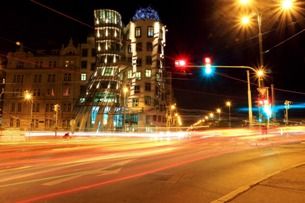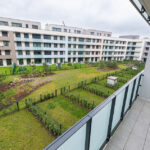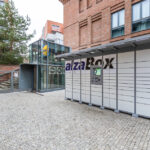While world-class experts valued the Dancing House as a great achievement, local architects refused it.
After the totalitarianism of austere prefab concrete architecture, it took them several years to accept the two dancing towers, “Ginger and Fred”. Today, the Dancing House is considered a ground-breaking piece of modern architecture.
The icon of the 1990s
The fame of the Dancing House in Prague is unprecedented. World-class figures of architecture with ties to the Czech Republic, including Vlado Milunić, Czech architect with Croatian roots, and Canadian-American architect Frank Gehry, were involved in its construction in the post-revolutionary period. The unique interior, designed by Eva Jiřičná, can pride on wavy floors, asymmetrical room and inclined walls.
Two coincidences and the construction
When the Allied forces bombed Prague at the end of World War II, they accidentally hit an apartment building on the banks of the Vltava River. About 50 years later, the unhappy coincidence provided an empty plot of urban land for the Dancing House. Two years passed from laying the foundation stone of the building in 1994 to opening the Dancing House to the public.
The second coincidence was the fact that Václav Havel lived next to the vacant lot and had some ideas about how to use the space. Together with architect Vlado Milunić, they came up with the Dancing House project, which included a library, café and theatre. However, at the turn of the 1980s and 1990s, they did not manage to find investors. Ironically, after the unique building was built in the early 1990s, it became a seat of several commercial companies. Its current owner, the Prague Real Estate Management, has opened the Dancing House Gallery to culture.
Culture in the Dancing House
The Dancing House Gallery presents works by Czech and international artists and designers. It focuses not only on famous names, but also on the presentation of young talents. For example, the popular design show – Prague Design Week 2017 – and a retrospective exhibition of Jan Kaplický, internationally renowned Czech architect, took place there. For the current programme of exhibitions, please see the gallery website.
After you visit the gallery, you can relax in the bar on the top floor of the Dancing House. The Ginger & Fred restaurant with an international menu, located on the 7th floor, offers a magnificent view of Prague Castle as well. Aesthetics plays an important role there not only in the stylish interior, full of works of modern art, but also in serving exquisite dishes.
How to get there
There is a bustle around the Dancing Around all the time. The building towers over a busy intersection between the Vltava embankment, Jirásek Bridge and Resslova Street. It is situated right in the middle of Prague’s major thoroughfares, but if you have a car, just drive past the building because it is almost impossible to park nearby.
Right at the Dancing House, there are tram and bus stops; the nearest metro station is Karlovo náměstí (yellow B line). If you leave the metro and come to Palackého náměstí Square, you can walk to the Dancing House along Rašínovo Embankment on the Vltava river bank. The house is open daily from 10 a.m. to 10 p.m.





